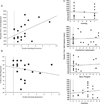Assessing neurocognitive function in psychiatric disorders: a roadmap for enhancing consensus
- PMID: 24994503
- PMCID: PMC4250359
- DOI: 10.1016/j.nlm.2014.06.011
Assessing neurocognitive function in psychiatric disorders: a roadmap for enhancing consensus
Abstract
It has been challenging to identify core neurocognitive deficits that are consistent across multiple studies in patients with Obsessive Compulsive Disorder (OCD). In turn, this leads to difficulty in translating findings from human studies into animal models to dissect pathophysiology. In this article, we use primary data from a working memory task in OCD patients to illustrate this issue. Working memory deficiencies have been proposed as an explanatory model for the evolution of checking compulsions in a subset of OCD patients. However, findings have been mixed due to variability in task design, examination of spatial vs. verbal working memory, and heterogeneity in patient populations. Two major questions therefore remain: first, do OCD patients have disturbances in working memory? Second, if there are working memory deficits in OCD, do they cause checking compulsions? In order to investigate these questions, we tested 19 unmedicated OCD patients and 23 matched healthy controls using a verbal working memory task that has increased difficulty/task-load compared to classic digit-span tasks. OCD patients did not significantly differ in their performance on this task compared to healthy controls, regardless of the outcome measure used (i.e. reaction time or accuracy). Exploratory analyses suggest that a subset of patients with predominant doubt/checking symptoms may have decreased memory confidence despite normal performance on trials with the highest working memory load. These results suggest that other etiologic factors for checking compulsions should be considered. In addition, they serve as a touchstone for discussion, and therefore help us to generate a roadmap for increasing consensus in the assessment of neurocognitive function in psychiatric disorders.
Keywords: Checking; Ignore-Suppress; Neurocognitive; Obsessive Compulsive Disorder (OCD); Serotonin reuptake inhibitors (SRIs); Working memory.
Copyright © 2014 Elsevier Inc. All rights reserved.
Figures




Similar articles
-
Effects of gender and executive function on visuospatial working memory in adult obsessive-compulsive disorder.Eur Arch Psychiatry Clin Neurosci. 2015 Dec;265(8):707-18. doi: 10.1007/s00406-015-0604-2. Epub 2015 May 14. Eur Arch Psychiatry Clin Neurosci. 2015. PMID: 25972085
-
Spatial working memory deficits in obsessive compulsive disorder are associated with excessive engagement of the medial frontal cortex.Neuroimage. 2003 Dec;20(4):2271-80. doi: 10.1016/j.neuroimage.2003.05.001. Neuroimage. 2003. PMID: 14683728
-
Examining procedural working memory processing in obsessive-compulsive disorder.Psychiatry Res. 2017 Jul;253:197-204. doi: 10.1016/j.psychres.2017.03.048. Epub 2017 Mar 27. Psychiatry Res. 2017. PMID: 28390295
-
[Neuropsychological update on obsessive-compulsive disorder].Rev Neurol. 2008 May 16-31;46(10):618-25. Rev Neurol. 2008. PMID: 18465702 Review. Spanish.
-
The role of working memory in compulsive checking and OCD: a systematic classification of 58 experimental findings.Clin Psychol Rev. 2011 Aug;31(6):1004-21. doi: 10.1016/j.cpr.2011.06.004. Epub 2011 Jun 22. Clin Psychol Rev. 2011. PMID: 21741340 Review.
Cited by
-
Evoking network profiles of the dorsal anterior cingulate in youth with Obsessive-Compulsive Disorder during motor control and working memory.J Psychiatr Res. 2021 Jan;132:72-83. doi: 10.1016/j.jpsychires.2020.09.028. Epub 2020 Oct 8. J Psychiatr Res. 2021. PMID: 33068817 Free PMC article.
-
Using mice to model Obsessive Compulsive Disorder: From genes to circuits.Neuroscience. 2016 May 3;321:121-137. doi: 10.1016/j.neuroscience.2015.11.009. Epub 2015 Nov 10. Neuroscience. 2016. PMID: 26562431 Free PMC article. Review.
-
Inhibitory Selection Mechanisms in Clinically Healthy Older and Younger Adults.J Gerontol B Psychol Sci Soc Sci. 2018 Apr 16;73(4):612-621. doi: 10.1093/geronb/gbw029. J Gerontol B Psychol Sci Soc Sci. 2018. PMID: 26976135 Free PMC article.
-
Executive Functioning and Clinical Variables in Patients with Obsessive-Compulsive Disorder.Brain Sci. 2021 Feb 20;11(2):267. doi: 10.3390/brainsci11020267. Brain Sci. 2021. PMID: 33672581 Free PMC article.
-
DISSECTING OCD CIRCUITS: FROM ANIMAL MODELS TO TARGETED TREATMENTS.Depress Anxiety. 2015 Aug;32(8):550-62. doi: 10.1002/da.22367. Epub 2015 May 7. Depress Anxiety. 2015. PMID: 25952989 Free PMC article. Review.
References
-
- Abbruzzese M, Ferri S, Scarone S. The selective breakdown of frontal functions in patients with obsessive-compulsive disorder and in patients with schizophrenia: A double dissociation experimental finding. Neuropsychologia. 1997;35:907–912. pii: S0028-3932(96)00095-4. - PubMed
-
- Abramovitch A, Abramowitz JS, Mittelman A. The neuropsychology of adult obsessive-compulsive disorder: A meta-analysis. Clinical Psychology Review. 2013;33:1163–1171. pii: 10.1016/j.cpr.2013.09.004S0272-7358(13)00130-X. - PubMed
-
- Alderson RM, Kasper LJ, Hudec KL, Patros CH. Attention-deficit/hyperactivity disorder (ADHD) and working memory in adults: A meta-analytic review. Neuropsychology. 2013;27:287–302. pii: 10.1037/a00323712013-16996-001. - PubMed
Publication types
MeSH terms
Grants and funding
LinkOut - more resources
Full Text Sources
Other Literature Sources
Medical

